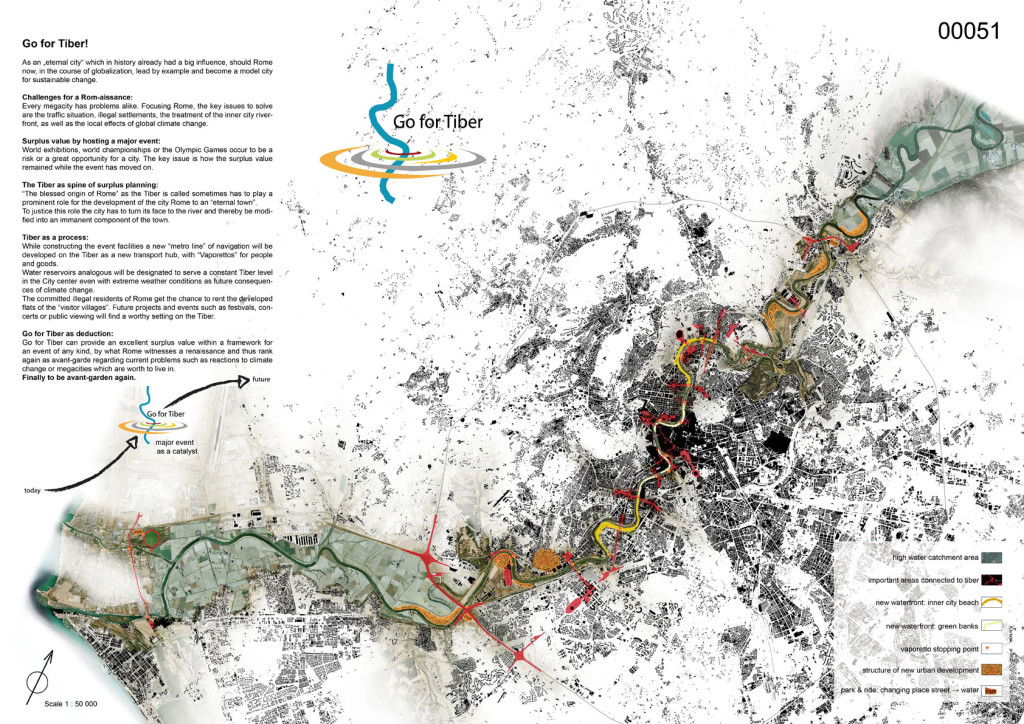Info:
Title: Within the wall - Code: 00049Contest: Rome / 2010
By: A. Gibb / B. Simpson / B. Newlands / C. Hill / K. Walker / J. Barkley / B. Mackay / R. Anderson / B. Burke / C. Bonner
Views: 2186 Likes: 0
Votes:
JUERGEN MAYER H. 0 FRANCESCO LIPARI6 FELIPE ESCUDERO6 FRANCESCO GATTI 4 MICHAEL CATON 64.4
Within the wall


TOWERS
Throughout history, people have always looked to Rome. It is a capital for ideas of civilisation, law, art, and architecture. The Italian instinct is to build upwards. The Ancient Romans built Insula, multi-storey apartment blocks; the Renaissance Italians built soaring domes and obelisks; and the Medieval Italians built towers.
“Private towers distinguish the Italian city-state as no other artefact: they were raised in large numbers – one for each noble family at Ferrara, over 300 at Rome…and were ambitiously tall.” 1
These towers were a prominent feature of the Italian skyline and could be up to 100m tall, but were usually no taller than the town hall. Commonly attached to the home of a powerful family, they were symbols of wealth, status and power. Rome had 300, Florence had 150 [Fig 3] and San Gimignano had 80 [Fig1], but they were common in every Italian city and town. San Gimignano is one of the few places where many examples can still be found. Rome also has a few surviving examples, namely the Torre delle Milizie and the Torre del Grillo.
There is very little visual evidence of the towered skyline from the medieval period. They are frequently referred to, however, in writing from the period, particularly from Florence with its rich pedigree of Journal writing. They are even mentioned in Dante’s inferno “we reached the bottom of that lofty tower.” 2 Dante had been exiled from Florence and was disturbed by the fighting within the city, and so he placed towers within the circle of hell.
Whilst they began as symbols of status, they dissolved into a means of defence between warring families. But what happened to the towers? In Florence, the fighting between rival families became so destructive that, in approx. 1300, a law was passed ordering them to be taken down, and the material was used to build the city walls. It is not clear what happened to the towers in Rome, or other cities, but it is likely that they were taken down for a similar reason, or that they were taken down due to disrepair, or even earthquake damage.
walls
Rome, as many other European cities, is a city within walls, much of which can still be seen [Fig 4]. Many other examples can still be seen, such as those in Lucca and the hill top town of San Gimignano.
Everything happened within these walls. People were born, lived, worked, and died there. It could be said that the medieval city within its walls is the perfect model of sustainability. Old maps of Rome [Fig 6], and also Florence and Edinburgh [Fig 5] show us their entire world contained within the walls. Everything is drawn with such care and attention, even detailing the produce in the gardens. Buonsignori’s perspective map of Florence, 1584, is beautiful in its attention to detail. Every element is carefully drawn and it is plain to see that Florence was a city which survived, in the main, within its city walls. In fact, during the siege of 1529-1530, the Florentines survived completely within the walls. Graffiti of the time stated “poor, but free” 3
vision
Whilst Rome no longer needs its walls and towers for defence, the benefits of both are still appropriate today. We need to nourish and enrich the city centre to prevent the need to go outside the walls, reducing commuting and importing.
Prominent figures throughout history have had visions for Rome. Julius Ceasar in the 1st Century BC, Constantine in the 3rd century AD, Il Duce at the beginning of the 20th Century and the radicals Superstudio in the 1960s. A broad brush master plan approach is not appropriate here. The city needs to accommodate incremental growth over time, and for a long time. After all, Rome was not built in a day.
One cannot deny the stigma attached to building high. Low quality tower block housing throughout Europe in the 20th Century has led to a negative reaction to high-rise. But these towers need not be a failure. High quality design and sufficient economic input ensure they remain adaptable and appropriate for a long time. Visually, as landmarks, they create an intriguing and exciting skyline. Environmentally they can provide a sensible relief from the heat of an Italian summer; “The height of the towers in the centre of town means they could conceivably cause downdraughts or in some areas, upcast, like chimney-stack ventilation.” 4
The emphasis for this approach is one of collaboration. Each tower must have a designer committed to the overall vision. By encouraging the towers to be developed over time, by many different individuals and for many different uses, one can ensure a rich and vibrant future for Rome.
When in Rome, do as the Romans did.






